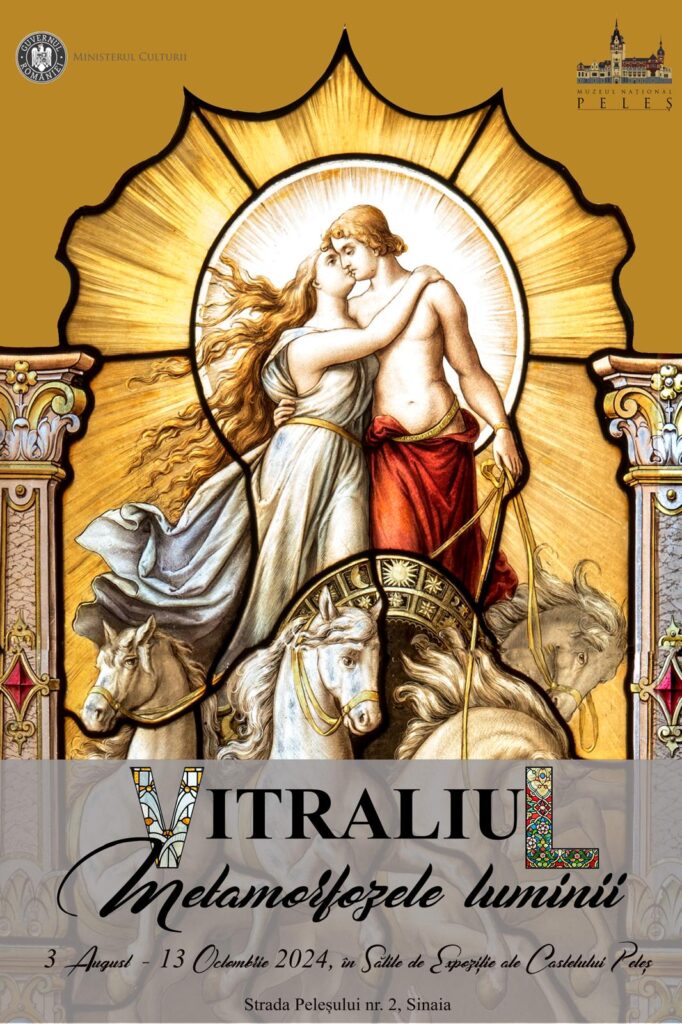The Peleș National Museum will open on Saturday, August 3, 2024, at 5:00 PM, in the exhibition halls of Peleș Castle, the temporary exhibition "Stained Glass. Metamorphoses of Light".
The temporary exhibition will be open to the public for free from August 4 to October 13, 2024, according to the Peleș Castle visiting schedule.
The art of stained glass – a complex, monumental art of light and color, in dialogue with architecture, using metallurgy and glass techniques, close to ceramics, but especially to painting, was born from the need for protection against the weather, but also from the need for natural lighting of interiors. By closing windows and doors with compositions of translucent materials, similar to mosaics, the need for beauty was also met, which has always animated artists. The profession of stained glass creator has the particularity of being related to glassmaking as well as ceramics and metallurgy. The glass craftsman has the chance to be a complete artist, who goes from conception to realization.
The birthplace of King Carol I, located in the city of Sigmaringen, was built in the 16th century, at the height of the Renaissance, and later perfected by entire generations of the king's ancestors. The atmosphere of this beloved castle, abandoned by Prince Carol of Hohenzollern-Sigmaringen to become King of Romania, whose destiny he changed, wants to be reconstructed at the foot of the Carpathians, in what he wanted to become the cradle of the dynasty, Peleș Castle. The over 800 artistic stained glass windows, which constitute an important component of the decoration of the castle and the entire architectural complex on the banks of the Peleș stream, are essential for achieving this goal.
The overwhelming majority of the artistic stained glass collection consists of pieces commissioned by King Carol I, especially for the Peleș and Pelișor castles, but also for adjacent buildings, from the companies FX Zettler, from Munich, and Zwölfer, from Vienna.
The workshops Zettler were highly appreciated in the European nobility and ecclesiastical sphere. Their owner, Franz Xaver Zettler (1841-1916), opened a workshop in 1871 which he called Stained Glass Painting Institute for Churches. The success of Zettler's creations is confirmed two years later, when the company's stained glass windows receive the Grand Prix at the Universal Exhibition in Vienna. In an era when medieval stained glass windows are being rediscovered, the Zettler company receives numerous orders, from Bavaria, the rest of Germany and abroad. FX Zettler becomes supplier to the Royal Court of Bavaria and receives the order Saint MichaelLater, he also received orders Franz Josef, Crown of Prussia and the order The Star of Romania, the latter from King Carol I. The themes of the stained glass collection of Peleș Castle are diverse, it includes religious subjects, scenes illustrating moments in the life of German nobles, military or hunting scenes, subjects related to the history of the Hohenzollern family, such as coats of arms and heraldic insignia, or portraits of the ancestors of King Carol I. The execution techniques adopted by FX Zettler are those used in European stained glass workshops, from the end of the 19th century. Specific to this period is the preservation, as much as possible, of the original elements, originating from the art of the 16th century, in parallel with the combination of new elements, made available by discoveries in the field of glass manufacturing or color chemistry.
The August Zwölfer workshops, which had their headquarters in Vienna but also a branch in Bucharest, executed, for the Peleș and Pelișor Castles, mainly pieces with a modern character, in the Art Nouveau style.
